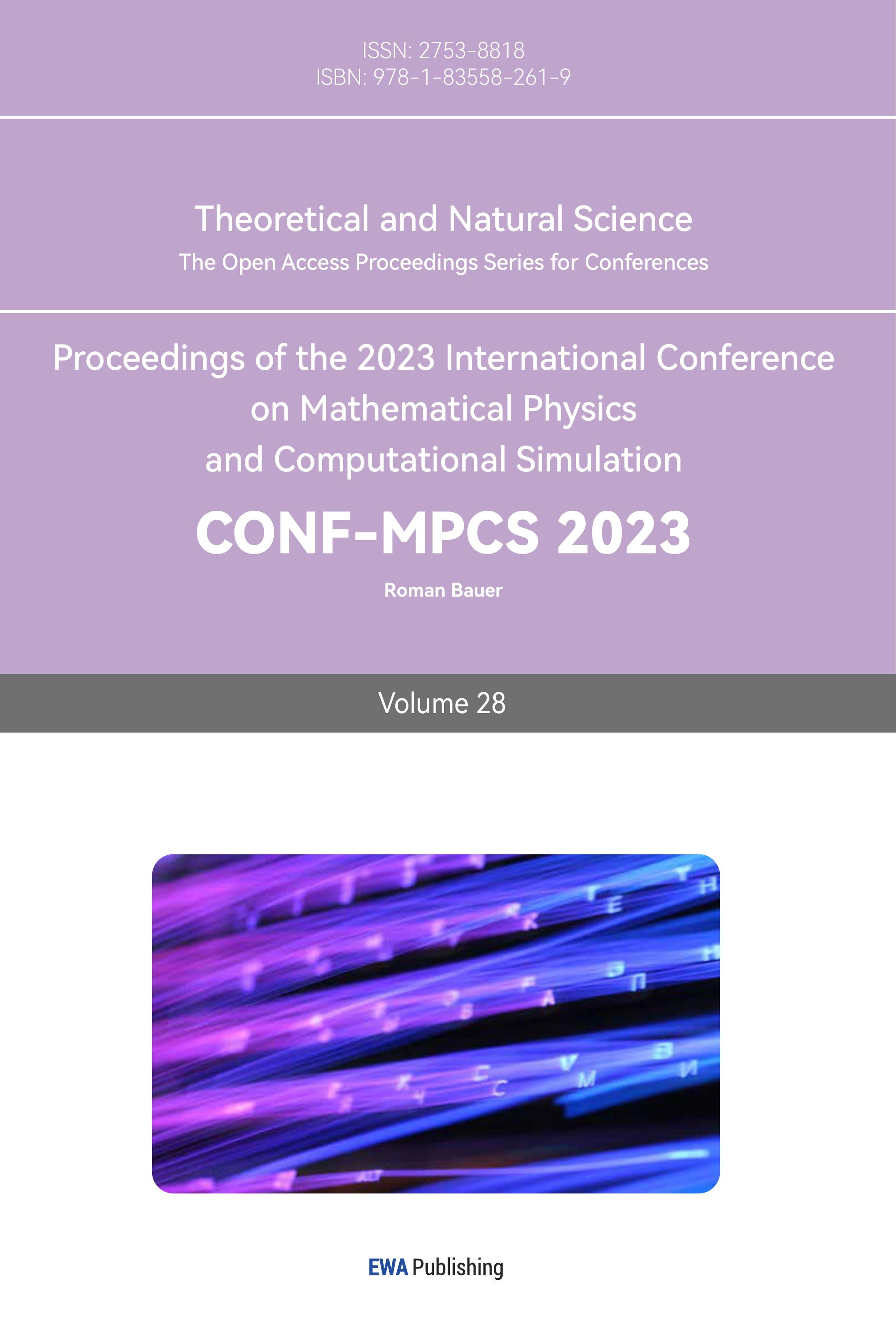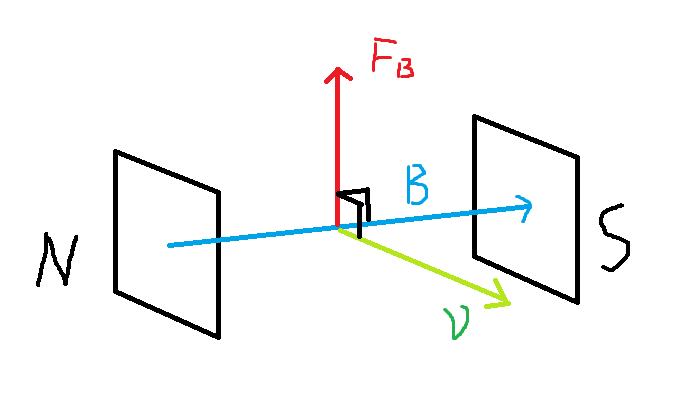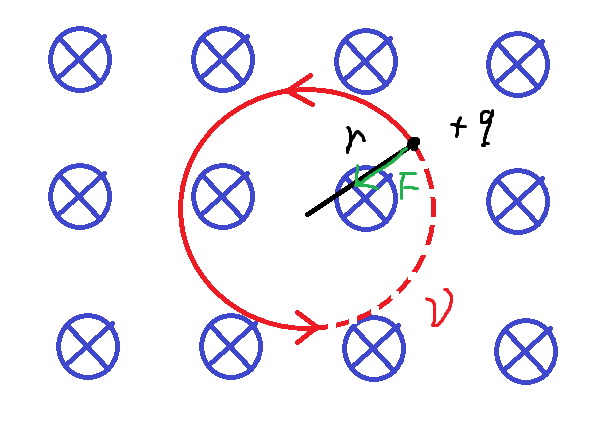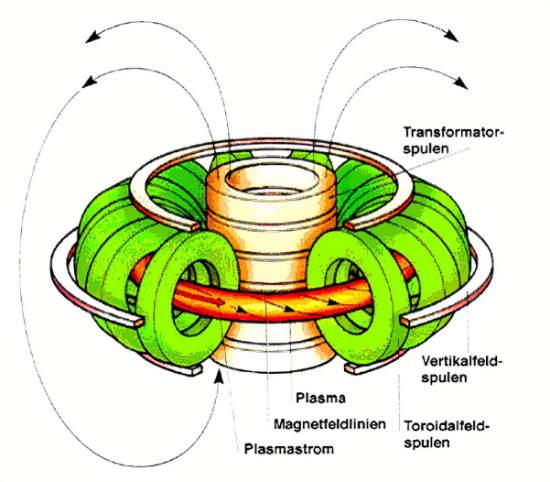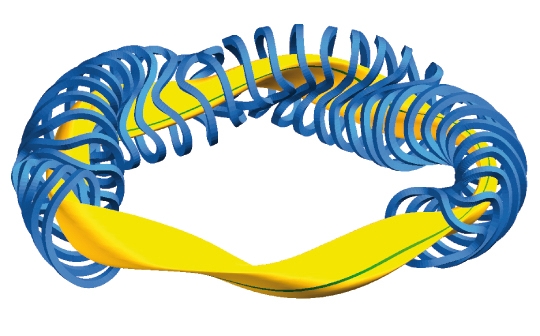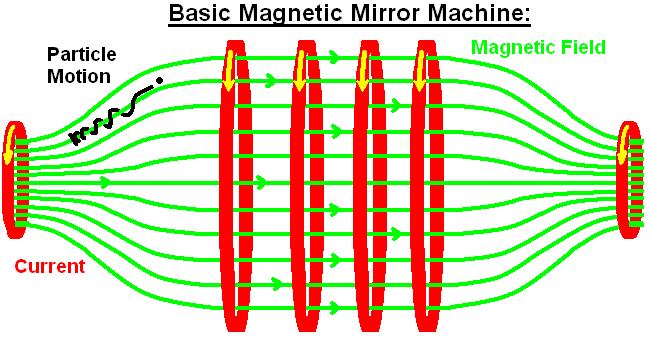1. Introduction
Nuclear fusion is a process that combines two lighter atomic nuclei to form a heavier core. Meanwhile, a large amount of energy is released due to the heart's mass loss, according to Einstein’s mass-energy equation.
\[E = MC^{2}\]
An example is the fusion of deuterium and tritium nuclei.
\[_{\text{1}}^{\text{2}}\text{D}^{\text{+}}\text{+}_{\text{1}}^{\text{3}}\text{T}^{\text{+}}\text{→}_{\text{2}}^{\text{4}}\text{He}^{\text{++}}\text{+}_{\text{0}}^{\text{1}}\text{n}\text{,}\]
Which has the highest reaction probability found. From experimental measurements, deuterium and tritium have less total mass than helium and the neutron; thus, theoretically, the group is transferred into 17.6 MeV energy. This is huge at the atomic scale.
In recent years, nuclear fusion has become a hotspot with the great potential to create a clean and almost infinite energy source. The realization of atomic fusion might lead to the next industrial revolution, just like steam to the first and electricity to the second.
Although the principle of nuclear fusion is simple and easy to understand, it is tough to realize atomic fusion due to the extreme conditions needed. Since nuclear fusion was discovered in the early 20th century, only uncontrollable atomic fusion, the hydrogen bomb, has been achieved. A continuous and controllable fusion reaction is necessary to benefit from nuclear fusion.
There are many types of fusion configurations proposed. Two main types of fusion are Magnetic Confinement Fusion (MCF) and Inertial Confinement Fusion (ICF), or called "Laser Fusion." The configuration with the highest hopes is "Tokamak" (one type of MCF). This was proposed in the mid-20th century and has been widely used worldwide. The most famous Tokamak is ITER, an international thermonuclear fusion reactor planned to be built in 2035, which will be one of the most significant international cooperation projects in the history of the world. In addition, many countries, institutions, and even private companies are also researching different nuclear fusion reactors, including but not limited to the tokamak, and have made a lot of progress and even proposed some new ideas. Hopefully, the success of controlled nuclear fusion will be achieved in the foreseeable future.
2. Nuclear Fusion in Nature
Nuclear fusion is a joint at the center of stars. In 1920, Arthur Eddington published an article, "The Internal Constitution of the Stars," and predicted the mechanism of nuclear fusion in stars[1]. In his theory, atomic fusion is sufficient to explain where the energy of stars comes from if there are a few fractions of hydrogen in stars. Nowadays, astronomical observations show that stars mainly consist of hydrogen and helium; meanwhile, in the 1950s, Raymond Davis Jr. detected the neutrons from the sun, proving the nuclear fusion process in stallers does exist [2]. And this should be the case for all the stars in the universe. This is reasonable for Stars. Stars are hot and dense enough, especially in the core of stars. For example, our sun's body is 15 million Kelvin hot and 300 billion times dense than our atmosphere. Also, the sun consists of 73% of hydrogen [3]. Thus, fusion frequently happens in stars, and much energy is released. This energy balances the star's gravitational potential energy and keeps the lead stable without collapsing until there is not enough hydrogen to continue the fusion process.
One other kind of fusion in nature is called Pycnonuclear fusion. They can be found in highly dense systems like neutron stars and white dwarfs. This sounds like the same fusion reaction in familiar stars but has different requirements. Pycnonuclear fusion happens when nuclei oscillate and overlap the others. Thus, it depends more on density instead of heat. The research on Pycnonuclear fusion is still in the preliminary stage [4, 5]. Compared to Thermonuclear fusion, Pycnonuclear fusion is less joint and Unattainable.
3. Discovery and the First Accomplishment of Nuclear Fusion.
In 1905, Einstein published his famous mass-energy equation. This became the basic principle of nuclear fusion and fission reactions. But at that moment, people had not realized these two processes. As mentioned above, in 1920, Arthur Eddington published an article that said that stars' energy might come from the fusion of hydrogen and helium [1]. Later Robert Atkinson and Fritz Houtermans measured the accurate masses of some light elements and proved that nuclear fusion should release lots of energy. Then in 1932, Mark Oliphant observed the atomic fusion of deuterium in a laboratory [6]. In 1951, researchers in the USA achieved the first practical nuclear fusion in their thermonuclear device test [7]. Although the process is uncontrollable, it stands for the start of the usage of nuclear fusion energy.
4. Artificial Nuclear Fusion
Since the discovery of the mechanism of nuclear fusion, human beings have wanted to use nuclear fusion energy. However, unlike nuclear fission, the extreme conditions required for nuclear fusion are prohibitive. Since the first atomic reactor was constructed, people thought there were 30 years away from fusion energy. Now the third 30 years is coming. Fusion is still the most significant problem being tackled now. Although there might be going to take another 30 years, considerable progress has been made during decades of research. The fusion energy is really within reach.
1. the Difficulty of Nuclear Fusion
Nuclear fusion is the process of combining two atomic nuclei into a single, heavier heart, releasing a tremendous amount of energy in the process due to loss of mass according to the mass-energy equation. However, despite decades of research and experimentation, achieving nuclear fusion has proven challenging and elusive. For two atomic nuclei to combine, they must be brought close enough that the short-range strong nuclear force can overcome the long-range electrostatic repulsion between them. This requires extremely high temperatures and pressures, on the order of millions of degrees and millions of times of atmospheric pressure.
Moreover, to use fusion energy, the reaction needs to be Self-sustaining, like the chain reaction of nuclear fission. Therefore, to reach high temperatures and pressure, fusion fuel must also be confined in such an environment for enough time. The relation is given by the triple product of Lawson criteria [8].
\[n \cdot T \cdot \tau_{E} > 3 \cdot 10^{21}k\mathbb{e}Vsm^{- 3}\]
Here n is the density of reacting nucleus, T is the temperature of particles, \(\tau_{E}\) is the energy confinement time. Lawson criteria illustrate that to achieve a sustainable fusion reaction, the triple product of the three factors needs to be larger than \(3 \cdot 10^{21}k\mathbb{e}Vsm^{- 3}\).
Lawson criteria thus also give the three ways to achieve nuclear fusion: increasing temperature, increasing pressure, or increasing the period of confining atomic fusion fuel.
2. Controllable Artificial Nuclear Fusion Configurations
The energy contained in nuclear fusion is incredible. For example, a person living in a normal industrialized country only needs the fuel of deuterium distilled from 250L water and tritium produced from 30g Li [9]. Achieving controllable nuclear fusion is thus an important goal now.
Compared to nuclear fission, fusion contains much more energy than fission, and most importantly, it's clean. Unlike nuclear fission, nuclear fusion won't create any radioactive products that might pollute the environment. However, the requirement of nuclear fusion is so extreme that only an uncontrollable method is currently achieved: The Hydrogen Bomb. But people are also trying to create a continuous, stable, mild fusion like the sun.
There are two main nuclear fusion branches: Inertial confinement fusion (ICF) and magnetic confinement fusion (MCF). Some other types are Z-pinch,
Magnetized target fusion, Field-reserve, etc.
1. Toroidal MCF. Tokamak and Stellarator. Magnetic confinement fusion, as its name means, uses magnetic fields to confine plasma fusion fuel in finite volume. Heat the fusion fuel inside the "container" to an extremely high temperature (hundreds of millions of kelvins) to achieve nuclear fusion.
When a charged particle goes across a uniform magnetic field, it experiences a Lorentz force perpendicular to the direction of motion, which is given by.
\[F_{B} = qv \times B\]
B is the magnetic field, q is the particle's charge, and v is the particle's velocity(Figure 1 and Figure 2).
Figure 1. Lorenz force, the force is orthogonal to the magnetic field and particle's velocity.
Figure 2. The motion of a positively charged particle in a uniform magnetic field.
This will make the particle moves in a circular orbit in the plane orthogonal to the magnetic field. If we create a series of magnets to create a helical structure, the particles can thus be confined in a particular range along the axis.
Toroidal MCF uses this idea to confine the charged plasma. By creating such a helical structure and connecting end to end to a donut structure, the plasma fusion fuel can thus determine in the vacuum donut by magnetic force without touching the system's edge (Figure 3).
.
Figure 3. The structure of magnets and magnetic fields in a toroidal structure.
However, the magnetic field in this structure is not uniform due to changing radius. Then the particles will move lateral to the magnetic lines and separate. To avoid this situation. 2 types of structures are proposed: the Tokamak and the Stellarator.
2. Tokamak. Tokamak adds a coil to the center of the ring. It electrifies it to generate a magnetic field, which combines with the magnetic field generated by the outer circles to form a helical net field that perfectly confines the plasma inside the "donut."
The most significant advantage of the tokamak is that it can create a continuous and stable plasma-bound body at very high temperatures. And by adding a series of external magnets, the internal plasma can be flexibly adjusted. Moreover, according to some research, the triple product value of a tokamak can be directly calculated through some of its physical parameters.
The main disadvantage of the Tokamak is that maintaining an electromagnetic field will generate a tremendous amount of heat. Thus it requires cooling down. However, the development of superconducting technology will make up for this [10] (Figure 4).
.
Figure 4. Structure of a tokamak device. Source ENS European Nuclear Society.
3. Stellarator
Stellarator uses a more straightforward method to create a similar helical magnetic field: changing the shape of magnets. The magnetic field is distorted to a proper shape by generating a complex three-dimensional geometry network. However, it is tough to find the form of the magnets. Nowadays, with the development of supercomputers, people can find solutions more accessible [11].
Compared to the tokamak, the stellarator does not require external input current to maintain the magnetic field. Stellarator also performs better stability as there's no influence from outward input currents (Figure 5).
Figure 5. Structure of a Stellarator device. Source Max-Planck Institut für Plasmaphysik.
Back to Lawson's criteria, Toroidal MCF can confine the plasma in a relatively stable state for longer. So lower temperatures and pressure are needed to achieve self-sustaining nuclear fusion. This is one of the advantages of this structure. Considering the system, the pressure inside the chamber is restricted, but the temperature can reach a very high level. Thus, this is not an obvious problem.
Another problem of this type of fusion is the size. Both tokamak and stellarator are needed to build larger to have better efficiency and higher triple product to reach Lawson criteria. Thus, they are more suitable for the power station. Some configurations like ICF are needed to create smaller fusion devices for use in places such as spacecraft.
1. Inertial Confinement Fusion (ICF). It is a complex method using the inertial effect of particles to constrain the particles themselves to achieve nuclear fusion reactions. The basic principle is it uses energy sources such as lasers to heat minor hydrogen isotopes (deuterium and tritium) to extremely high temperatures in the plasma state. Then in a concise period, before this plasma has time to scatter to the surroundings, these plasma particles are compressed through the method of centripetal implosion, which means exploding the targets' outer layers to produce forces to a center to a high temperature and high-density state, thereby leading to a nuclear fusion reaction [12] (Figure 6).
Figure 6: Image of the steps of an ICF fusion process.1. Laser heats the fuel target. 2. Fuel “explore" and compress by recoil. 3. The compression of fuel, fuel reaches exceptionally high temperature and pressure during a brief period 4. Reach the limits, and fusion occurs. Source Benjamin D. Esham (2007).
The difficulty of this technology lies in how to ensure that the plasma fuel is compressed to the center, which requires:
1. The raw material ball itself is perfectly symmetrical in all directions
2. The compression shock wave generated by blasting the outer layer has the same intensity in all directions.
The improvement of modern precision processing technology has solved the first problem. The second problem is seeking solutions because the laser is difficult to control. One method currently proposed is indirect heating, putting fuel into a heavy metal container and using a laser Heating the container emits uniform X-rays. Still, it is challenging to sustain nuclear fusion in this way.
The advantages of ICF are significant. The fusion device is small and can be loaded in some restricted places. The more straightforward installations also reduce the difficulty of maintenance. But there are also many problems, one of which is the inefficient use of the lasers needed to create a fusion environment; the input energy needs to be transferred into the laser, then moved to the fuel target; these processes will waste a large proportion of energy. Most importantly, fusion can only be produced in pulses, resulting in less confinement time and higher temperature and pressure requirements.
2. Magnetic Mirror and Z-Pinch. Four concepts of controlling MCF thermonuclear fusion have been unveiled since the 1950s: the stellarator, the magnetic mirror, the pinch, and the tokamak [13], Magnetic mirrors and Z-pinch are two other types of magnetic confinement fusion besides tokamak and stellarator.
1. Magnetic Mirror. The magnetic mirror is a structure with coils with current in the same direction. Thus it creates a spindle-shaped magnetic field, which can confine the fusion fuel inside the spindle-shaped region. This device is simple but has a fatal problem. Fusion fuels will usually escape from the confinement region. Thus, this device has not been developed since 1970, but this confinement structure is still used in a tokamak (Figure 7).
Figure 7. The basic configuration of a Magnetic Mirror. Source Dr. Matthew J. Moynihan (2013).
2. Z-pinch. In essence, Z-pinch is similar to a variant of inertial confinement fusion. Compared with inertial confinement fusion, which uses a laser to compress the fuel, Z-pinch uses Lorentz force to achieve the purpose of compression. Thus it is also considered magnetic confinement fusion. Its basic principle is placing a fuel target at the center of a cylindrical structure, creating a vast axial current to generate a substantial magnetic field and compress the side of the cylinder towards the central fuel; when colliding, there will create enormous pressure by compression and temperature will increase due to conversion of kinetic energy [14].
The advantage of this device is that the efficiency is much higher than that of laser confinement fusion. Still, the disadvantage is that it can only be compressed in a ring, while inertial confinement fusion is spherical compressed fuel, so the compression efficiency is lower and uneven. Of course, the
4. other types of fusion devices
Many other types of other fusion devices exist, such as Magnetized target fusion and Collision Ion Beam Fusion. Most of the structures and principles of these devices are very delicate and usually have some specific advantages but are accompanied by some intractable disadvantages. Therefore, they are not widely used or only valued by a few institutions and private companies with a few resources.
5. Conclusion
Since the discovery of nuclear fusion in the early stage of the last century, it has been considered a promising source of clean and virtually limitless energy, as it produces no greenhouse gases or long-lived radioactive waste. Artificial fusion has been a topic of research for many decades. In order to achieve this, many nuclear fusion devices with different structures and principles have been proposed, people are moving in different directions and different paths, but to the same destination. One of the world's most considerable cooperation has also been launched for this purpose. These projects have reached significant progress. Although they are still facing numerous challenges, the future is still optimistic.
Eddington, A, S (1920) The internal constitution of the stars.
Davis Jr, R., & Harmer, D. S. (1956). Nuclear explosions in the sun. Nature, 178(4527), 649-650
Stanford Solar Centre (2008)The Sun's Vital Statistics. http://solar-center.stanford.edu/ vitalstats.html
Afanasjev, A.V.; Gasques, L.R.; Frauendorf, S.; Wiescher, M (2022) Pycnonuclear Reaction. 1.
Son. S., Fisch N.J. (2005) Pycnonuclear reaction and possible chain reactions in an ultra-dense DT plasma.
Mark Oliphant (1934) Transmutation Effects Observed with Heavy Hydrogen
E. Teller, The Super Bomb (1951) Bulletin of the Atomic Scientists, vol. 7, no. 9, pp. 296-299,
J.D. Lawson, (1955) Some criteria for a power producing thermonuclear reactor, Proceedings of the Physical Society. Section B, Volume 70, Number 1
Kirk (2015) Nuclear fusion: bringing a star down to Earth
E.J. Doyle1, W.A. Houlberg2, Y. Kamada3, V. Mukhovatov4, T.H. Osborne5, A. Polevoi4, G. Bateman6, J.W. Connor7, J.G. Cordey7, T. Fujita3 (2007) Plasma confinement and transport, Nuclear Fusion, Volume 47, Number 6
Clery. D. (2015). The bizarre reactor that might save nuclear fusion. https://www.science. org/content/article/bizarre-reactor-might-save-nuclear-fusion izarre reactor that might save nuclear fusion | Science | AAAS
Atzeni, S., Meyer-ter-Vehn, J. (2004). The physics of inertial fusion: beam plasma interaction, hydrodynamics, hot dense matter. Oxford University Press.
Matteo Barbarino, (2020), a brief history of nuclear fusion, Nature Physics 16, 890-893(2020)
U. Shumlak,(2020) Z-pinch fusion, Journal of Applied Physics 127, 200901(2020) https://doi.org/10.1063/5.0004228
References
[1]. Eddington, A, S (1920) The internal constitution of the stars.
[2]. Davis Jr, R., & Harmer, D. S. (1956). Nuclear explosions in the sun. Nature, 178(4527), 649-650
[3]. Stanford Solar Centre (2008)The Sun's Vital Statistics. http://solar-center.stanford.edu/ vitalstats.html
[4]. Afanasjev, A.V.; Gasques, L.R.; Frauendorf, S.; Wiescher, M (2022) Pycnonuclear Reaction. 1.
[5]. Son. S., Fisch N.J. (2005) Pycnonuclear reaction and possible chain reactions in an ultra-dense DT plasma.
[6]. Mark Oliphant (1934) Transmutation Effects Observed with Heavy Hydrogen
[7]. E. Teller, The Super Bomb (1951) Bulletin of the Atomic Scientists, vol. 7, no. 9, pp. 296-299,
[8]. J.D. Lawson, (1955) Some criteria for a power producing thermonuclear reactor, Proceedings of the Physical Society. Section B, Volume 70, Number 1
[9]. Kirk (2015) Nuclear fusion: bringing a star down to Earth
[10]. E.J. Doyle1, W.A. Houlberg2, Y. Kamada3, V. Mukhovatov4, T.H. Osborne5, A. Polevoi4, G. Bateman6, J.W. Connor7, J.G. Cordey7, T. Fujita3 (2007) Plasma confinement and transport, Nuclear Fusion, Volume 47, Number 6
[11]. Clery. D. (2015). The bizarre reactor that might save nuclear fusion. https://www.science. org/content/article/bizarre-reactor-might-save-nuclear-fusion izarre reactor that might save nuclear fusion | Science | AAAS
[12]. Atzeni, S., Meyer-ter-Vehn, J. (2004). The physics of inertial fusion: beam plasma interaction, hydrodynamics, hot dense matter. Oxford University Press.
[13]. Matteo Barbarino, (2020), a brief history of nuclear fusion, Nature Physics 16, 890-893(2020)
[14]. U. Shumlak,(2020) Z-pinch fusion, Journal of Applied Physics 127, 200901(2020) https://doi.org/10.1063/5.0004228
Cite this article
Niu,S. (2023). Nuclear fusion introduction and artificial fusion status. Theoretical and Natural Science,28,10-17.
Data availability
The datasets used and/or analyzed during the current study will be available from the authors upon reasonable request.
Disclaimer/Publisher's Note
The statements, opinions and data contained in all publications are solely those of the individual author(s) and contributor(s) and not of EWA Publishing and/or the editor(s). EWA Publishing and/or the editor(s) disclaim responsibility for any injury to people or property resulting from any ideas, methods, instructions or products referred to in the content.
About volume
Volume title: Proceedings of the 2023 International Conference on Mathematical Physics and Computational Simulation
© 2024 by the author(s). Licensee EWA Publishing, Oxford, UK. This article is an open access article distributed under the terms and
conditions of the Creative Commons Attribution (CC BY) license. Authors who
publish this series agree to the following terms:
1. Authors retain copyright and grant the series right of first publication with the work simultaneously licensed under a Creative Commons
Attribution License that allows others to share the work with an acknowledgment of the work's authorship and initial publication in this
series.
2. Authors are able to enter into separate, additional contractual arrangements for the non-exclusive distribution of the series's published
version of the work (e.g., post it to an institutional repository or publish it in a book), with an acknowledgment of its initial
publication in this series.
3. Authors are permitted and encouraged to post their work online (e.g., in institutional repositories or on their website) prior to and
during the submission process, as it can lead to productive exchanges, as well as earlier and greater citation of published work (See
Open access policy for details).
References
[1]. Eddington, A, S (1920) The internal constitution of the stars.
[2]. Davis Jr, R., & Harmer, D. S. (1956). Nuclear explosions in the sun. Nature, 178(4527), 649-650
[3]. Stanford Solar Centre (2008)The Sun's Vital Statistics. http://solar-center.stanford.edu/ vitalstats.html
[4]. Afanasjev, A.V.; Gasques, L.R.; Frauendorf, S.; Wiescher, M (2022) Pycnonuclear Reaction. 1.
[5]. Son. S., Fisch N.J. (2005) Pycnonuclear reaction and possible chain reactions in an ultra-dense DT plasma.
[6]. Mark Oliphant (1934) Transmutation Effects Observed with Heavy Hydrogen
[7]. E. Teller, The Super Bomb (1951) Bulletin of the Atomic Scientists, vol. 7, no. 9, pp. 296-299,
[8]. J.D. Lawson, (1955) Some criteria for a power producing thermonuclear reactor, Proceedings of the Physical Society. Section B, Volume 70, Number 1
[9]. Kirk (2015) Nuclear fusion: bringing a star down to Earth
[10]. E.J. Doyle1, W.A. Houlberg2, Y. Kamada3, V. Mukhovatov4, T.H. Osborne5, A. Polevoi4, G. Bateman6, J.W. Connor7, J.G. Cordey7, T. Fujita3 (2007) Plasma confinement and transport, Nuclear Fusion, Volume 47, Number 6
[11]. Clery. D. (2015). The bizarre reactor that might save nuclear fusion. https://www.science. org/content/article/bizarre-reactor-might-save-nuclear-fusion izarre reactor that might save nuclear fusion | Science | AAAS
[12]. Atzeni, S., Meyer-ter-Vehn, J. (2004). The physics of inertial fusion: beam plasma interaction, hydrodynamics, hot dense matter. Oxford University Press.
[13]. Matteo Barbarino, (2020), a brief history of nuclear fusion, Nature Physics 16, 890-893(2020)
[14]. U. Shumlak,(2020) Z-pinch fusion, Journal of Applied Physics 127, 200901(2020) https://doi.org/10.1063/5.0004228





